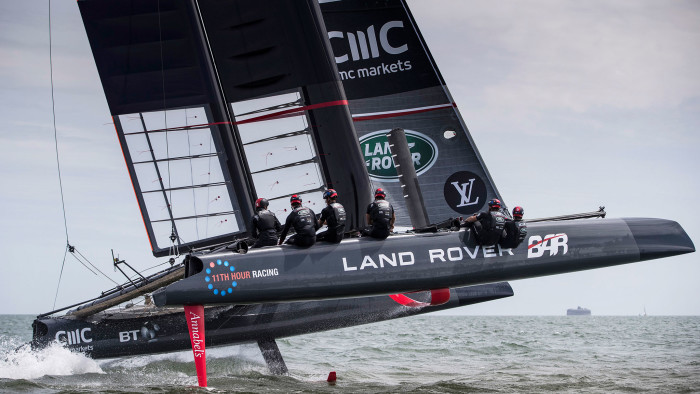Hydrofoils take hold in leading yacht race events

Roula Khalaf, Editor of the FT, selects her favourite stories in this weekly newsletter.
The arrival of hydrofoil technology in the America’s Cup, the oldest trophy in international sport, has split opinion. Some who follow the event marvelled at the technology and the dramatic change in the sport’s speed and appearance. Others were less impressed, claiming that catamarans flying above the water’s surface had little in common with most people’s understanding of sailing. Yet foiling has percolated through the sport and is engaging a new generation of sailors.
Hydrofoils are not new. In 1898, Italian inventor Enrico Forlanini obtained patents in the UK and US for his hydrofoil designs; their basic principle raises boats out of the water using wing-like structures beneath the hull to reduce drag and increase speed.
The big budgets associated with the America’s Cup have triggered a wave of development. “Hydrofoiling isn’t new, but what has changed are the materials and control systems that now make foiling viable,” says Martin Whitmarsh, former boss of the McLaren Formula One motor-racing team and now chief executive of the Land Rover BAR America’s Cup team.
“The recent developments in America’s Cup racing are on a par with those that were developed in motorsport such as crossply tyres, fuel injection, ABS braking systems and the like. With foiling, sailing is facing a similar revolution,” he adds.
But the catalyst for the move to foils came from a much smaller boat, the International Moth. This skinny, unstable, lightweight, single-handed 3.35 metre-long dinghy embraced foiling many years ago. While it has a reputation for being tricky to sail, there has been no shortage of those wanting to give it a go. The recent world championships attracted 240 entries; many of the professional sailors came straight from the America’s Cup.
Foiling has grown quickly in other areas of dinghy racing. Boats such as Phantom International’s Flying Phantom and Nacra’s F20 have done much to attract a new generation of sailors.
UK boat builder White Formula has produced one of the first foiling catamaran dinghies aimed at club sailors, the Whisper, which is capable of more than 20 knots. “The America’s Cup is about sailing on the ragged edge, but what we wanted to produce was a foiling boat that would be user-friendly for amateur sailors,” says Rob White, founder of White Formula. The company is planning to go into full production of another foiling boat, the F101, a three-hulled trimaran, again aimed at amateur sailors.
On the professional racing scene, the Extreme Sailing Series, a touring event where 9.75m catamarans are raced close to the shore in front of spectators, has moved to foils with its new fleet. The Olympics is also turning to foils, with the Nacra 17 class set for Tokyo 2020.
Hydrofoils lend themselves better to multihulls than single-hulled boats. Multihulls are generally lighter for their size and achieve a better power-to-weight ratio, so it is easier to make foils work. But that has not stopped those in the monohull world from seeking to exploit the benefits.
The Mini Transat class of single-handed race boats designed to cross the Atlantic is leading the way. The next generation include some that will lift out of the water on their foils like multihulls. The technology has yet to be proved in a major race, but there are already other classes which are heading down a similar path. The recently launched Figaro Beneteau 3, a 30ft offshore racer, comes with retractable foils as standard.
Some teams in the recent Vendée Globe, the single-handed, nonstop around-the-world race, exploited a loophole in rules to develop semi-foiling boats. More boats with foils are expected for the next race in 2020.
While opinion might have been split over the use of hydrofoils in this year’s America’s Cup, the technology is already sweeping through the sport.

Comments